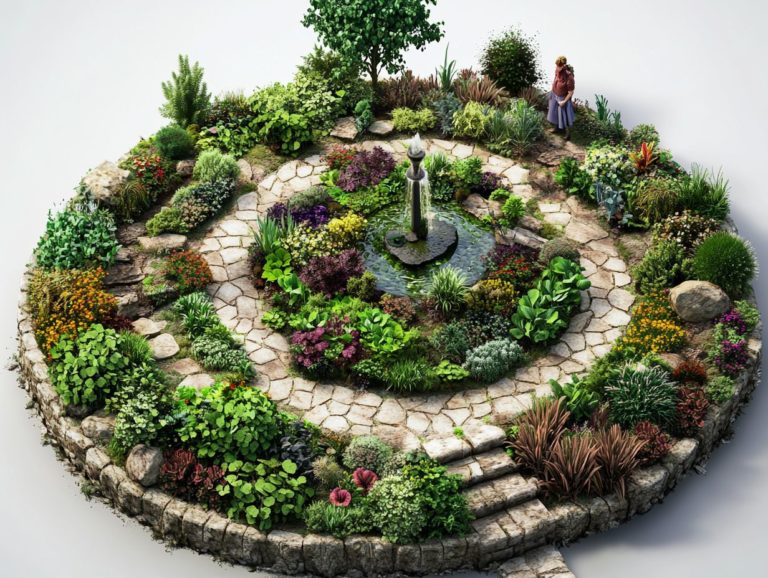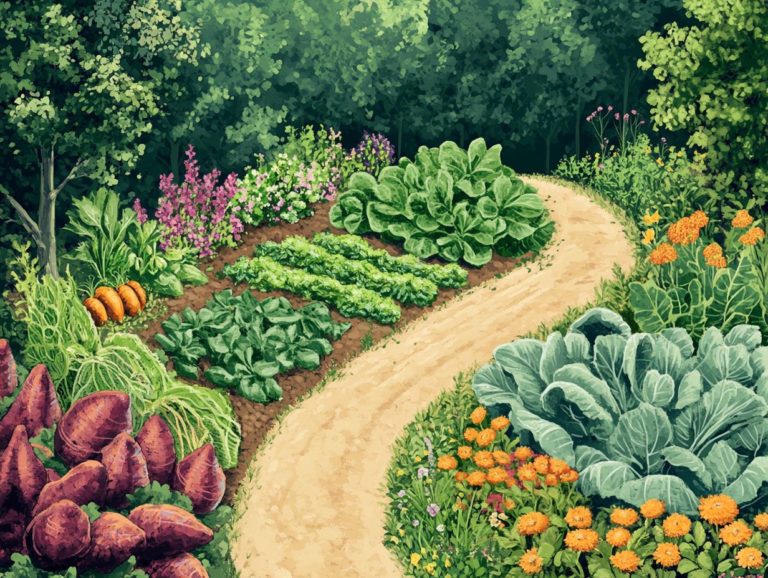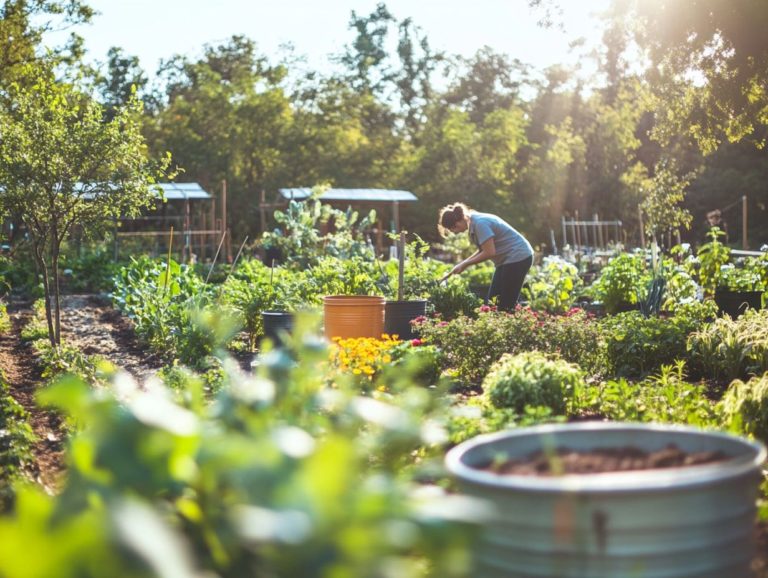What are the Principles of Permaculture Design?
Permaculture design is more than just gardening; it embodies a complete way to cultivate sustainable ecosystems that nurture the earth and all its inhabitants while promoting harmonious coexistence.
This article delves into the core principles of permaculture, highlighting its foundational ethics Earth Care, People Care, and Fair Share essential components of the permaculture philosophy.
Understanding the twelve guiding principles helps you create productive landscapes that also promote environmental health through sustainable practices.
Unlock the transformative power of permaculture design today and explore how it can reshape your relationship with the natural world, enhancing your ecological awareness.
Contents
- Key Takeaways:
- Understanding Permaculture Design
- The Three Ethics of Permaculture
- The Twelve Principles of Permaculture Design
- 1. Observe and Interact
- 2. Catch and Store Energy
- 3. Obtain a Yield
- 4. Apply Self-Regulation and Accept Feedback
- 5. Use and Value Renewable Resources and Services
- 6. Produce No Waste
- 7. Design from Patterns to Details
- 8. Integrate Rather than Segregate
- 9. Use Small and Slow Solutions
- 10. Use and Value Diversity
- 11. Use Edges and Value the Marginal
- 12. Creatively Use and Respond to Change
- Frequently Asked Questions
- What are the Principles of Permaculture Design?
- Are the Principles of Permaculture Design universal?
- Why are the Principles of Permaculture Design important?
- How many Principles of Permaculture Design are there?
- Can the Principles of Permaculture Design be combined with other design methodologies?
- Is it necessary to follow all the Principles of Permaculture Design in a project?
Key Takeaways:
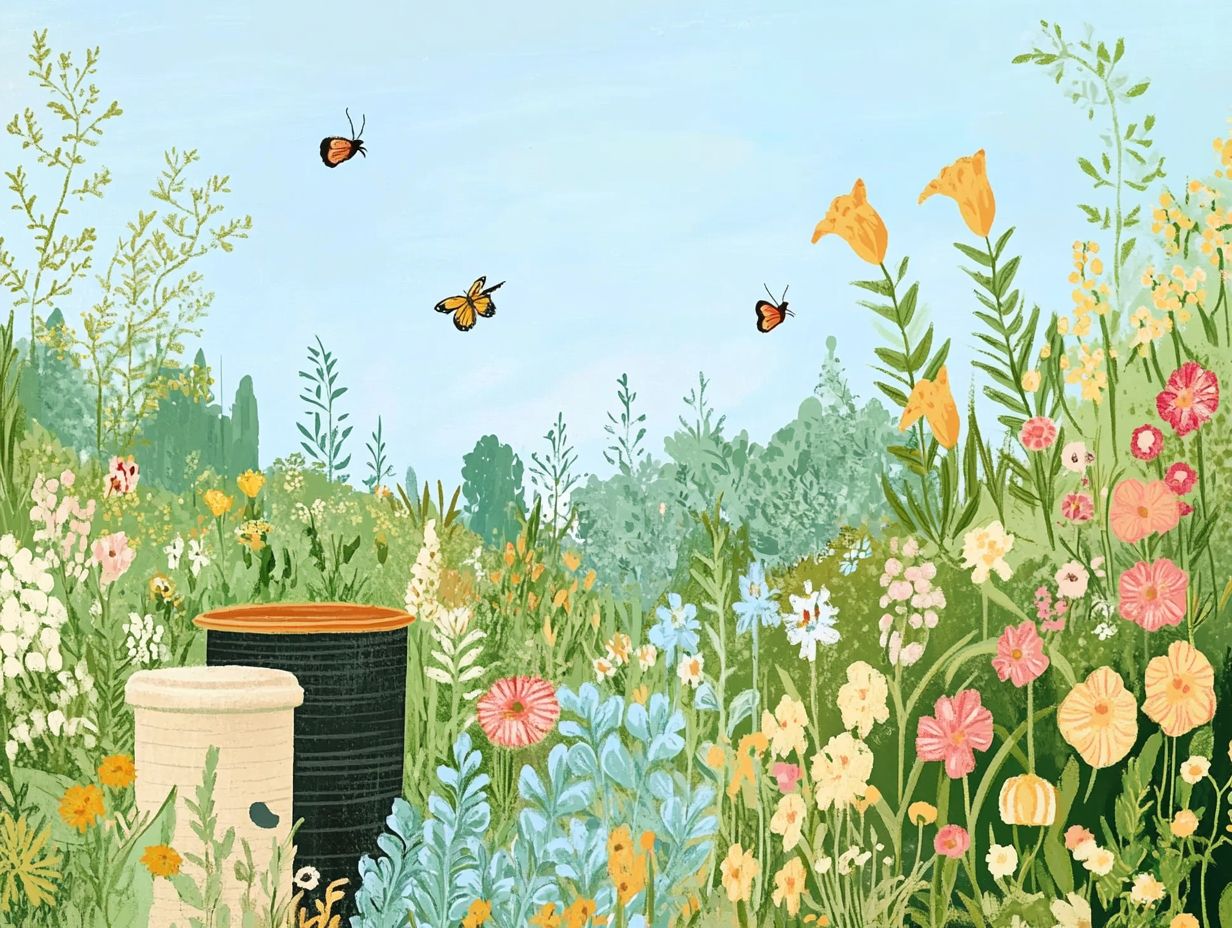
- The three ethics of permaculture include caring for the earth, caring for people, and sharing resources fairly.
- The twelve principles of permaculture design include observing and interacting, catching and storing energy, and using and valuing diversity.
- Permaculture design aims to create sustainable and regenerative systems by working with nature and utilizing ethical principles and design techniques.
Understanding Permaculture Design
Understanding Permaculture Design entails a deep dive into sustainable practices that strive to cultivate harmonious ecosystems, inspired by visionaries like David Holmgren and Bill Mollison. This complete framework weaves together ecological principles with ethical values, such as Earth Care, People Care, and Fair Share, establishing itself as a crucial methodology for today s environmental science and sustainable agriculture, promoting the concept of resource sharing.
Permaculture is more than just gardening or urban farming; it represents a philosophy that nurtures ecological awareness and resilience within local communities, ultimately guiding you toward a more sustainable lifestyle.
Definition and Goals of Permaculture
Permaculture is a complex system of agricultural and social design principles that revolves around mimicking the patterns and features found in natural ecosystems.
This approach creates self-sustaining environments that optimize land productivity while minimizing waste. By cultivating diverse crops and interdependent species, you enhance not only ecological awareness but also promote sustainable practices essential for tackling environmental challenges.
Your efforts contribute to resilient communities, where local resources are utilized efficiently, ensuring food security and reducing dependence on external supply chains. Ultimately, embracing permaculture principles fosters biodiversity, nurtures healthy ecosystems, and cultivates a sense of community, enabling you to take an active role in the journey toward sustainable living.
The Three Ethics of Permaculture
The Three Ethics of Permaculture serve as your ethical compass, steering you through the realms of sustainable design and practices. They underscore the profound interconnectedness between environmental sustainability and social equity, guiding you toward a more harmonious approach to living and creating.
Care for the Earth
Caring for the Earth is a cornerstone of permaculture, highlighting the importance of sustaining and regenerating our ecological systems by honoring biodiversity and harnessing renewable resources.
This ethical principle fosters a harmonious relationship between you and the natural world while also playing a critical role in the sustainability and resilience of various ecological systems.
Explore practices like agroforestry and regenerative agriculture; these approaches exemplify this commitment by enhancing soil health and promoting a rich diversity of plant and animal life. Not only do these methods capture carbon to help mitigate climate change, but they also create ecosystems that are resilient against pests and diseases.
By prioritizing strategies that embody this care, you can cultivate landscapes that are not only productive but also ecologically balanced, ensuring a thriving environment for generations to come.
In conclusion, applying permaculture principles can lead to a more sustainable future. Embrace these practices to help create a healthier planet for all.
Care for People
Care for People is a fundamental ethical principle in permaculture that emphasizes building community resilience, driving social change, and addressing local needs through collaboration and support.
This principle transcends individual well-being; it embodies shared values that strengthen connections among community members and encourages community gardening. By fostering inclusive dialogue and cooperative efforts, it promotes social equity and tackles disparities head-on.
Community gardens are exciting spaces where people come together to share resources, knowledge, and skills while growing fresh produce. These gardens foster sustainability and resilience within local communities. What else do they provide? They cultivate relationships and enable marginalized groups.
Workshops teaching sustainable practices and permaculture education reflect this commitment beautifully. They ensure that everyone, regardless of their background, has the tools and knowledge necessary to contribute actively and fairly to their community’s growth.
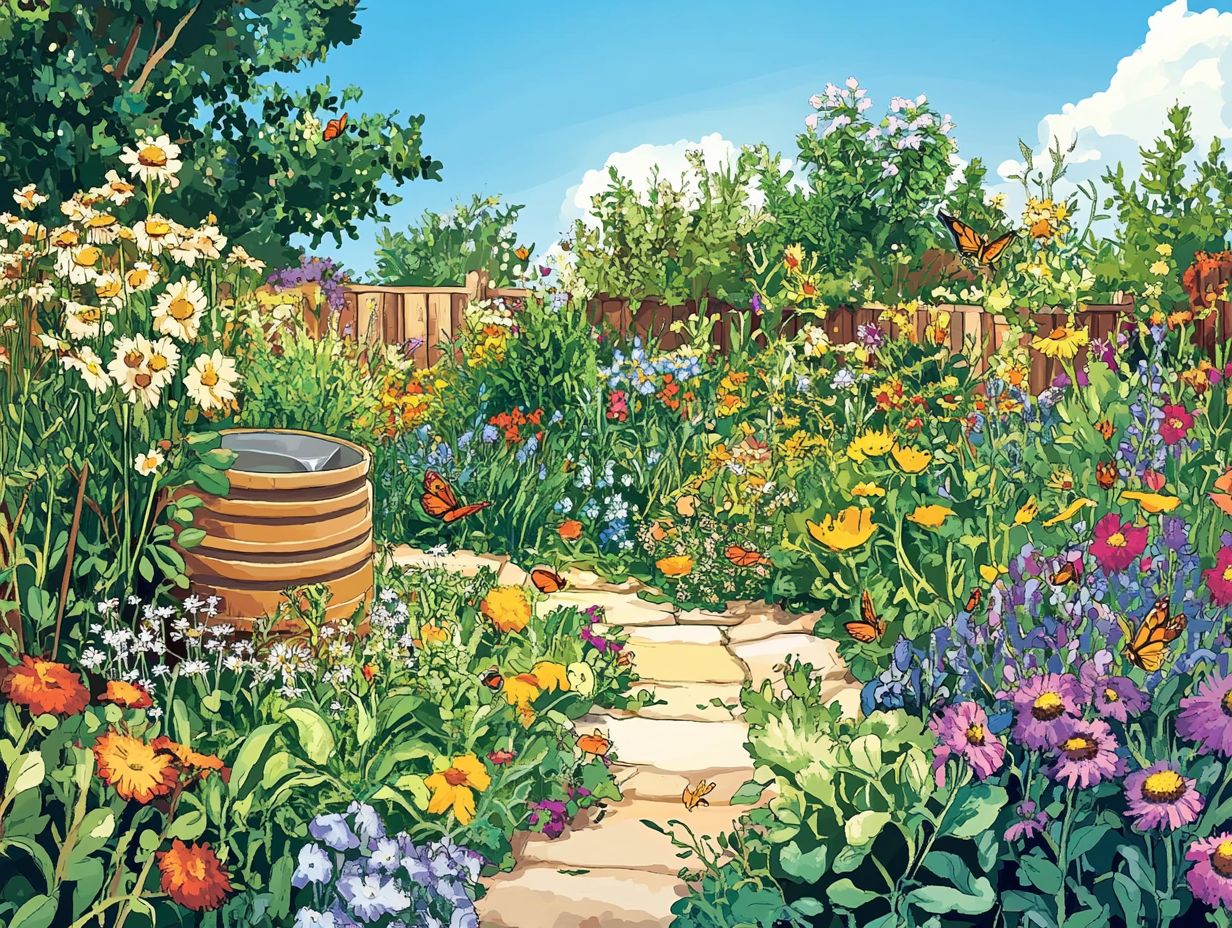
Fair Share means sharing resources fairly, encouraging you to embrace a sustainable lifestyle through responsible consumption and resource sharing, promoting community sufficiency.
This principle can be woven into various community initiatives aimed at advancing environmental justice and sufficiency. For example, when neighborhoods unite to cultivate shared spaces, they don t just gain access to fresh produce; they also forge stronger communal bonds.
Community fridges and seed exchanges illustrate how you can meet collective needs while minimizing waste and addressing disparities in food access. Cooperative businesses adhering to fair trade principles embody this ethos, ensuring that both producers and consumers benefit.
By fostering local economies and nurturing equitable relationships, you can join now to help create a more sustainable future one that enriches lives while honoring the planet.
The Twelve Principles of Permaculture Design
The Twelve Principles of Permaculture Design stand as your essential guide for adopting sustainable practices within a holistic framework. They emphasize the importance of energy conservation and the role of design in permaculture gardening and self-regulation.
By embracing these principles, you cultivate a deeper ecological awareness and foster a harmonious relationship with nature.
1. Observe and Interact
The principle of Observe and Interact highlights the significance of engaging with and understanding natural systems through meticulous observation and responsive action key aspects of the design process.
By immersing yourself in the environment, you can uncover the subtle dynamics at play, enabling you to make informed decisions that enhance design outcomes and optimize resource use. For instance, by observing how rainwater naturally flows across a landscape, you can strategically position swales (shallow channels) or rain gardens (landscaped areas designed to capture rainwater), effectively managing runoff and improving water retention. This thoughtful analysis conserves water and nurtures healthier ecosystems.
In permaculture, feedback systems can refine your practices and enhance the design principles you’re applying. By utilizing composting techniques that adapt based on the observed decomposition rate, you create a continuous loop of learning that fosters resilience and sustainability.
2. Catch and Store Energy
Catch and Store Energy invites you to harness and conserve renewable resources, enhancing the efficiency and sustainability of ecosystems.
This approach includes methods such as utilizing solar panels to capture sunlight and convert it into electricity through renewable energy solutions, along with innovative water collection techniques to harvest rainwater for irrigation or household use.
The importance of energy conservation in sustainable design cannot be overstated. It encourages responsible use of resources, minimizes waste, and maximizes output.
By integrating these practices into modern architecture and urban planning, you can help create resilient infrastructure that supports a more sustainable future while benefiting both the environment and the economy.
3. Obtain a Yield
Obtaining a yield is a fundamental principle in permaculture that emphasizes the importance of producing food and resources sustainably. It ensures resilience in your food production systems through practices like companion planting, which is growing different plants together to enhance growth and repel pests.
By fostering an environment where you and your community actively engage in gardening practices such as organic gardening, you can secure a steady supply of fresh produce and simultaneously strengthen the local economy. Think of urban community gardens that breathe new life into vacant lots, transforming them into vibrant spaces where you can cultivate vegetables and herbs right in your neighborhood.
These initiatives not only bolster food security but also promote biodiversity, with diverse plant species enhancing the health of local ecosystems and contributing to climate adaptation. They also provide great learning opportunities, allowing you to learn about sustainable agriculture practices and ecological building techniques. Through these innovative approaches, you can achieve self-sufficiency and deepen your connection to the food cycle.
4. Apply Self-Regulation and Accept Feedback
Applying self-regulation and embracing feedback is crucial as you adapt your practices to align with ecological principles and foster continuous improvement in your permaculture systems.
This approach keeps your projects focused on sustainable goals and enables you to make real-time adjustments that enhance overall effectiveness. For example, you can implement self-assessment protocols to evaluate the health of your soil and plant systems, promoting a natural balance.
By observing changes in crop productivity or pest populations, you can make informed decisions that uphold ecological integrity. Engaging in feedback loops, such as community workshops where participants share their observations and experiences, further enriches your process. This collaboration allows you to refine your methods and ultimately cultivate a more resilient agricultural ecosystem.
5. Use and Value Renewable Resources and Services
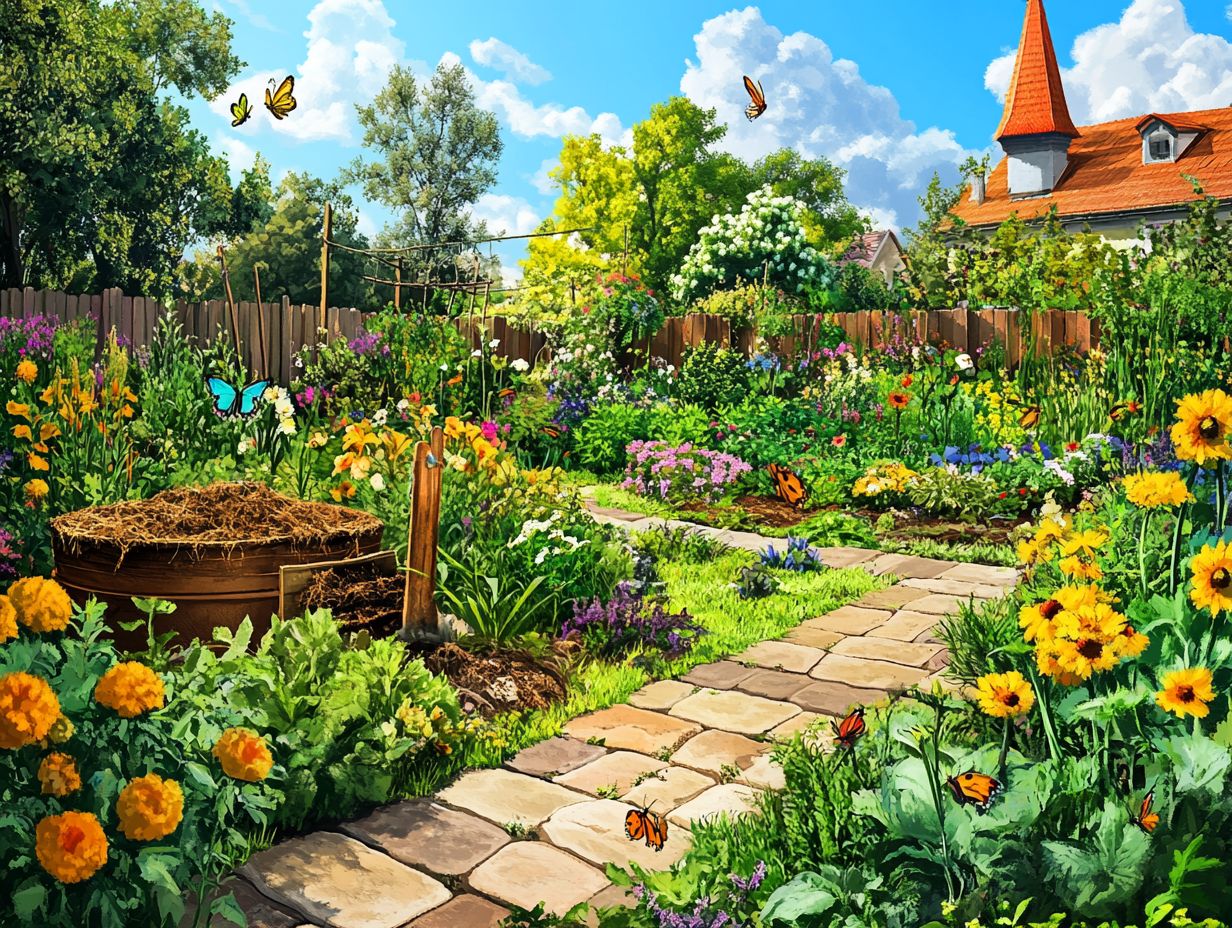
Using and valuing Renewable Resources and Services underscores the importance of sustainably managing resources to create efficient, self-sustaining ecosystems. This principle invites you to seamlessly integrate natural systems into your agricultural practices, where renewable resources like solar energy, rainwater, and organic matter become vital players.
Imagine harnessing solar power to significantly cut your reliance on fossil fuels or implementing rainwater harvesting techniques to reduce the need for traditional irrigation methods. By valuing and utilizing these resources, you can enhance soil fertility through composting, leading to healthier crop yields. Embracing these practices not only boosts biodiversity, fostering habitats that support various species, but also cultivates a more resilient environment.
This connection helps local ecosystems thrive and makes resource use more efficient, allowing you to cultivate a harmonious relationship between agriculture and nature.
6. Produce No Waste
The principle of Produce No Waste challenges you to adopt practices that minimize waste and foster ecological awareness by creating closed-loop systems.
This approach emphasizes the significance of techniques like composting, which transforms organic waste into nutrient-rich soil, and recycling, which repurposes materials to lessen the demand for new resources.
By incorporating these methods into your daily routine, you can substantially reduce the amount of waste destined for landfills. For instance, using compost bins for kitchen scraps not only cuts down on waste but also enriches your garden soil, promoting healthier plant growth.
Moreover, educational initiatives can pave the way for increased participation in recycling programs, helping others grasp the value of responsible consumption and the environmental benefits that come with embracing sustainable practices.
Start composting today and join the movement towards a waste-free future!
7. Design from Patterns to Details
Designing from Patterns to Details highlights the importance of understanding broader ecological patterns before focusing on specific design elements. This approach leads to more effective ecological design.
By recognizing these patterns, you can create systems that work efficiently and fit harmoniously within the environment. For example, observing how forests develop in layers can help you establish multi-tiered planting schemes that maximize space and light.
Understanding how water moves in a landscape allows you to place swales and ponds strategically, which enhances water retention.
These methods ensure your design is both resilient and sustainable, reflecting nature s ability to adapt and thrive in various conditions.
8. Integrate Rather than Segregate
Integrating Rather than Segregating encourages you to connect the different components of an ecosystem, resulting in more resilient and diverse environments.
This principle is a game-changer in permaculture design, where the harmonious interactions among plants, animals, and humans foster sustainable communities. Take community gardening, for instance; companion planting beautifully illustrates this concept. By growing different plants together, you can boost growth and improve pest control, creating a thriving garden.
Consider how diverse ecosystems work like forests, where trees, shrubs, and ground cover support each other. Observing these relationships shows the benefits of integration. By building connections in community gardens, you can mimic natural systems, leading to better soil health, increased biodiversity, and more sustainable food sources for your community.
9. Use Small and Slow Solutions
The principle of using small and slow solutions invites you to embrace gradual, manageable changes that help the environment grow stronger.
Implementing small-scale interventions reveals how minor adjustments contribute to long-term ecological balance. For example, adding a rain garden in your yard captures stormwater and nurtures local biodiversity. These small changes deepen your understanding of ecosystem responses, fostering a culture of learning and adaptation.
Techniques like polycultures growing multiple plant species together and companion planting promote diverse crop growth, reduce pest issues, and enhance soil health over time. The cumulative effect of these efforts creates a vibrant environment, showing that true sustainability often arises from patience and thoughtful stewardship.
10. Use and Value Diversity
Using and valuing diversity emphasizes the critical role of biodiversity in building resilient and adaptive ecosystems. In your permaculture practices, this principle is essential for ensuring systems can endure disturbances while remaining productive.
Consider a polyculture garden; by incorporating a variety of plants, you boost soil fertility and attract beneficial insects and pollinators. Diverse ecosystems, like mixed forests or grasslands, show how species interdependence fosters stability. When one organism faces challenges, others can thrive, ensuring that ecosystem functions continue.
This interconnectedness is especially vital in the context of climate change. A rich tapestry of species can better withstand and recover from environmental shifts, fulfilling the promise of sustainability in your agricultural endeavors.
11. Use Edges and Value the Marginal
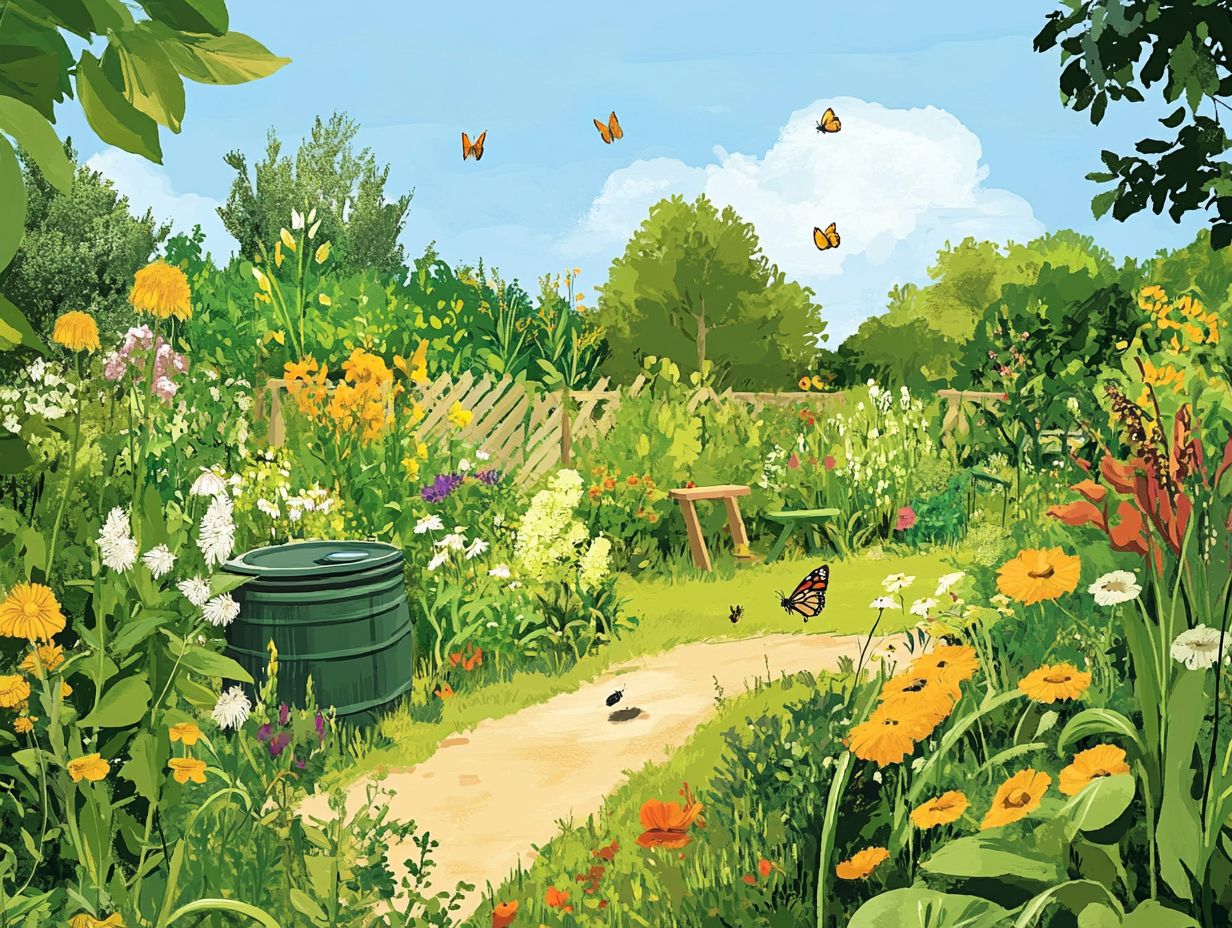
Using Edges and Valuing the Marginal emphasizes the effects of boundaries between different environments in ecosystems, where diverse species interactions come together to create enhanced ecological outcomes.
These marginal areas, often dismissed as mere transitional zones, are vital havens for wildlife. They promote a rich tapestry of biodiversity. In permaculture design, recognizing the potential of these edges allows you to integrate various habitats, from pollinator gardens to fruit-bearing shrubs.
For example, establishing a buffer of native plants between fields and water bodies stabilizes soil and attracts beneficial insects and birds.
By creatively utilizing these spaces, you can significantly enhance ecological health. This fosters resilient ecosystems that thrive on the intricate relationships nurtured in these unique environments.
12. Creatively Use and Respond to Change
The principle of Creatively Using and Responding to Change invites you to embrace flexibility and innovation within your permaculture practices, acknowledging the dynamic nature of ecosystems.
This concept is crucial now more than ever as environmental conditions evolve due to climate change and human activity.
As a permaculture practitioner, adapt by adjusting your crop selections in response to shifting soil and climate conditions. Opt for resilient varieties that thrive amidst more extreme moisture or temperature fluctuations.
By implementing techniques like swales shallow channels that help manage water runoff or rain gardens, you can effectively manage excess water during heavy rains. This conserves resources and reduces erosion.
These creative responses boost productivity and deepen your connection with the ecosystem. They foster a holistic approach that benefits both the environment and your community.
Frequently Asked Questions
What are the Principles of Permaculture Design?
The Principles of Permaculture Design are a set of guidelines that help create sustainable and regenerative systems based on natural patterns and principles.
Are the Principles of Permaculture Design universal?
Yes, the Principles of Permaculture Design can be applied to any location, culture, and scale. This makes it a versatile and adaptable design framework.
Why are the Principles of Permaculture Design important?
The Principles of Permaculture Design help us create resilient and self-sufficient systems. They work in harmony with nature, promoting ecological balance and minimizing our impact on the environment. For those interested in implementing these principles, understanding the steps for creating a permaculture design emphasizes Earth Care, People Care, and Fair Share.
How many Principles of Permaculture Design are there?
There are 12 Principles of Permaculture Design, originally developed by Bill Mollison and David Holmgren in the 1970s. They serve as an ethical compass for sustainable practices.
Can the Principles of Permaculture Design be combined with other design methodologies?
Yes, the Principles of Permaculture Design can be integrated with other design approaches, such as biomimicry, regenerative design, and sustainable design. This provides a holistic framework for ecological systems.
Is it necessary to follow all the Principles of Permaculture Design in a project?
No, the Principles of Permaculture Design are not rigid rules. They are guidelines that can be adapted and prioritized according to the specific needs and conditions of a project or site. This promotes diverse ecosystems and community sufficiency.

